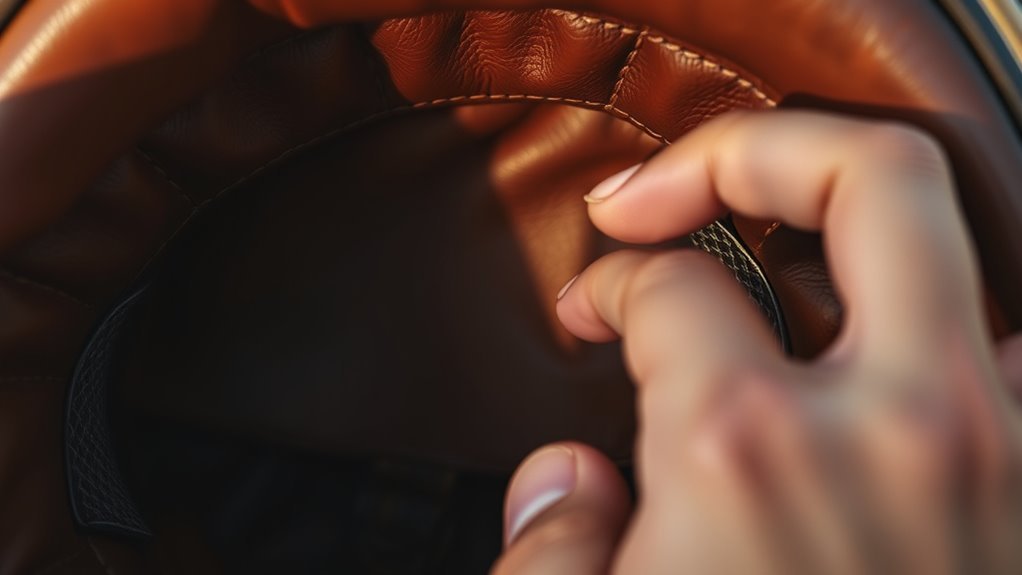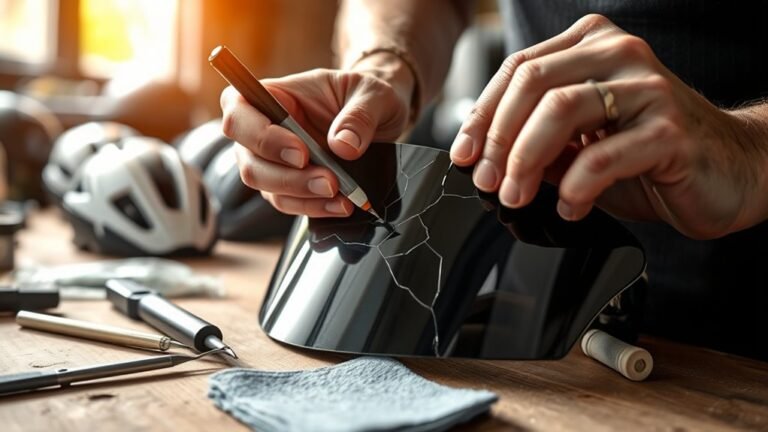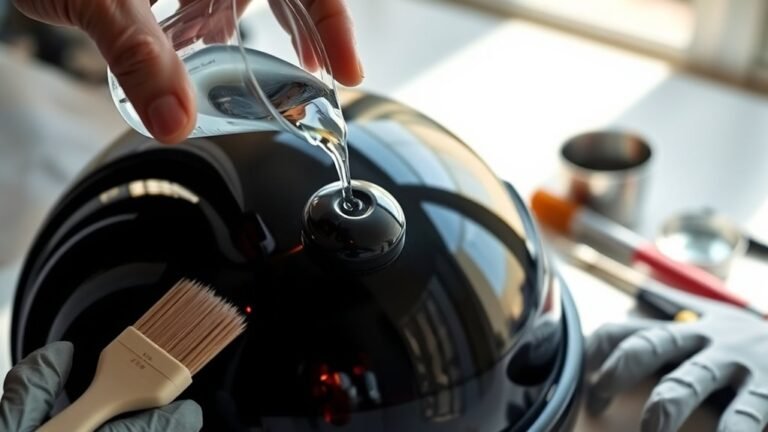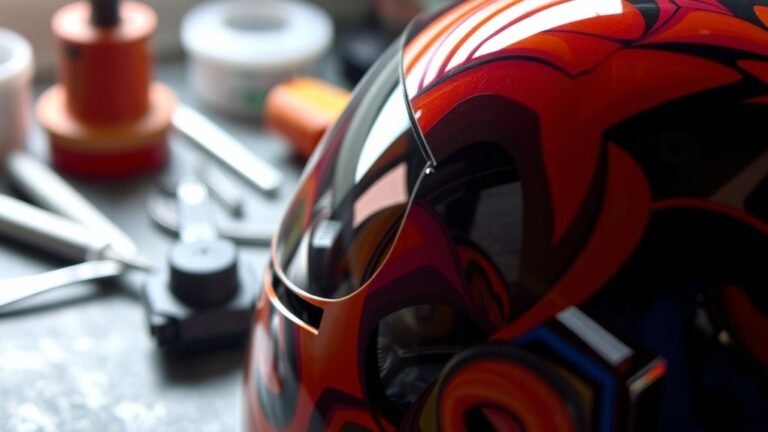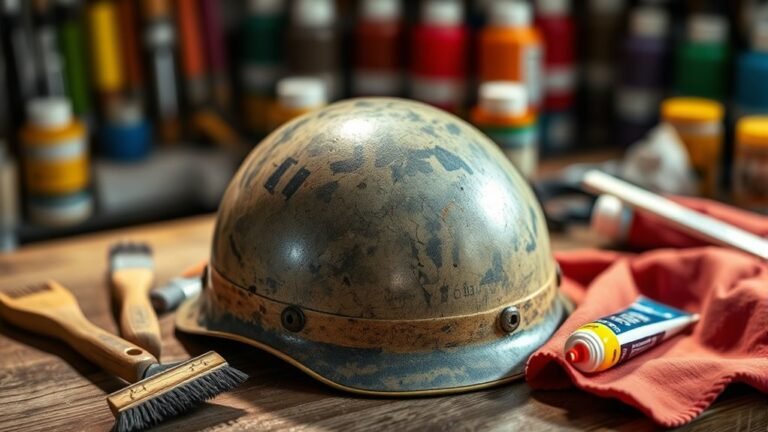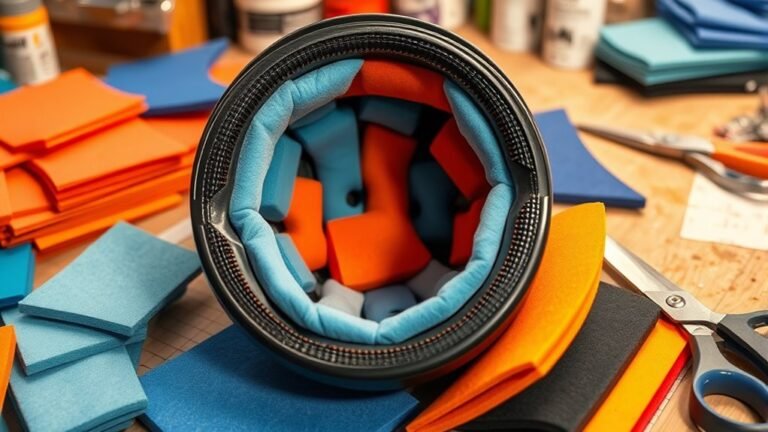Caring for Leather Helmet Interiors
Caring for leather helmet interiors is essential for comfort and safety. Start by identifying the leather type, then use a damp cloth with mild soap to clean, followed by air drying. Condition your helmet every 4 to 6 weeks with a suitable product to prevent dryness. Regularly air it out and inspect for wear. Store it in a cool, dry place, and use a helmet bag. Discover more tips to enhance your helmet’s longevity.
Understanding Leather Helmet Interiors
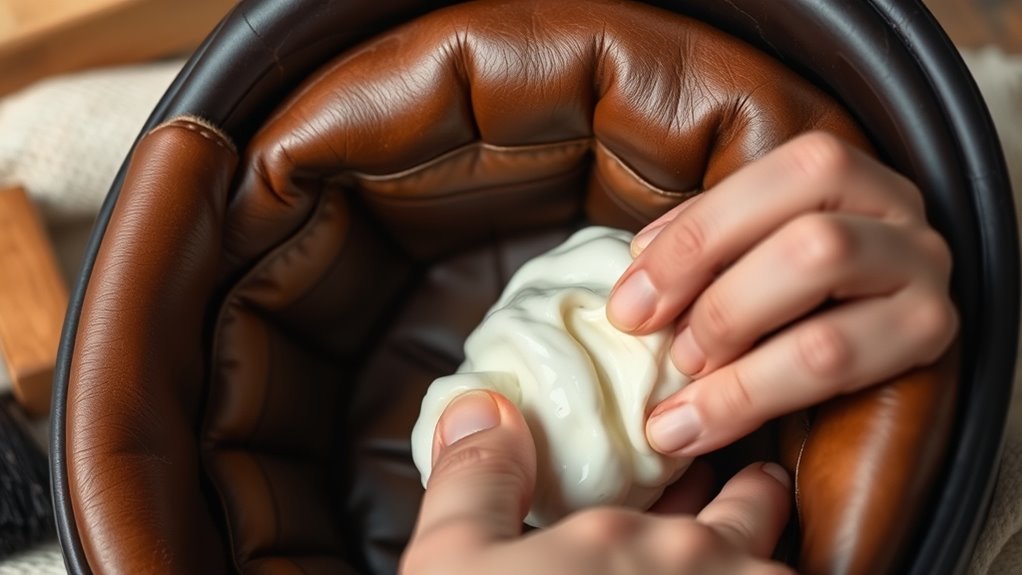
When you think about leather helmet interiors, it’s important to recognize that they serve more than just aesthetic purposes; they play an essential role in comfort and safety. Different leather types, such as cowhide or goatskin, offer unique benefits, providing durability and breathability. When selecting a helmet, pay attention to the interior padding, which absorbs shock and minimizes pressure points. High-quality padding enhances fit, ensuring the helmet stays snug during activities. Additionally, leather’s natural properties allow for moisture wicking, keeping your head comfortable even in warm conditions. Understanding these elements will empower you to choose a helmet that not only looks good but also prioritizes your safety and comfort, allowing you to enjoy your freedom with peace of mind.
Essential Cleaning Supplies
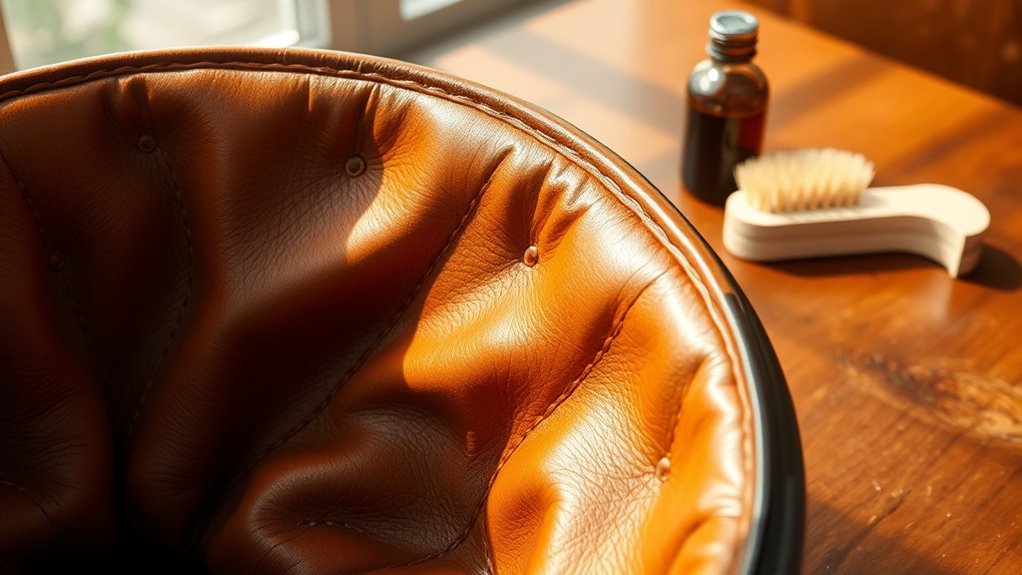
When caring for your leather helmet interior, having the right cleaning supplies is essential. You’ll want to gather recommended cleaning products that are gentle yet effective, along with appropriate tools for application. Additionally, considering protective treatments can help maintain the integrity and appearance of the leather over time.
Recommended Cleaning Products
Choosing the right cleaning products is essential for maintaining the integrity and appearance of leather helmet interiors. When it comes to leather care, you’ll want to prioritize product safety to avoid damaging your helmet. Here are some recommended options that balance effectiveness and gentleness:
| Product Type | Recommended Brand | Purpose |
|---|---|---|
| Leather Cleaner | Lexol | Cleans and conditions |
| Mild Soap | Dr. Bronner’s | General dirt removal |
| Leather Conditioner | Bickmore Bick 4 | Restores moisture |
| Disinfectant Spray | Lysol | Sanitizes surfaces |
| Natural Oil | Coconut Oil | Nourishes leather |
These products guarantee you maintain a pristine helmet while caring for the leather effectively.
Tools for Application
Essential tools for applying cleaning products to leather helmet interiors can make a significant difference in the effectiveness of your maintenance routine. Start with microfiber cloths, which are gentle yet effective for applying cleaning solutions without damaging the leather. Soft-bristled brushes are also invaluable for reaching into seams and crevices, ensuring thorough cleaning. Consider using cotton swabs for precision in hard-to-reach areas. When it comes to application methods, opt for spray bottles for even distribution of cleaning solutions, or use a damp cloth for controlled application. Remember to have a leather conditioner on hand, as it restores moisture after cleaning. With the right application tools and methods, you’ll keep your leather helmet interiors in top shape, allowing for both functionality and freedom.
Protective Treatments Available
To maintain the integrity of your leather helmet interiors, incorporating protective treatments is just as important as using the right cleaning supplies. Start by selecting high-quality protective sprays designed specifically for leather. These sprays create a barrier against moisture and dirt, helping to prevent damage from the elements. Additionally, consider using specialized leather treatments that nourish and condition the material, keeping it supple and preventing cracks.
Before applying any treatment, verify the interior is clean and free from residues. Regularly using these protective products not only extends the life of your helmet but also enhances its appearance. Remember, a little care goes a long way—so invest in the right protective measures to enjoy the freedom of your leather gear for years to come.
Step-by-Step Cleaning Process
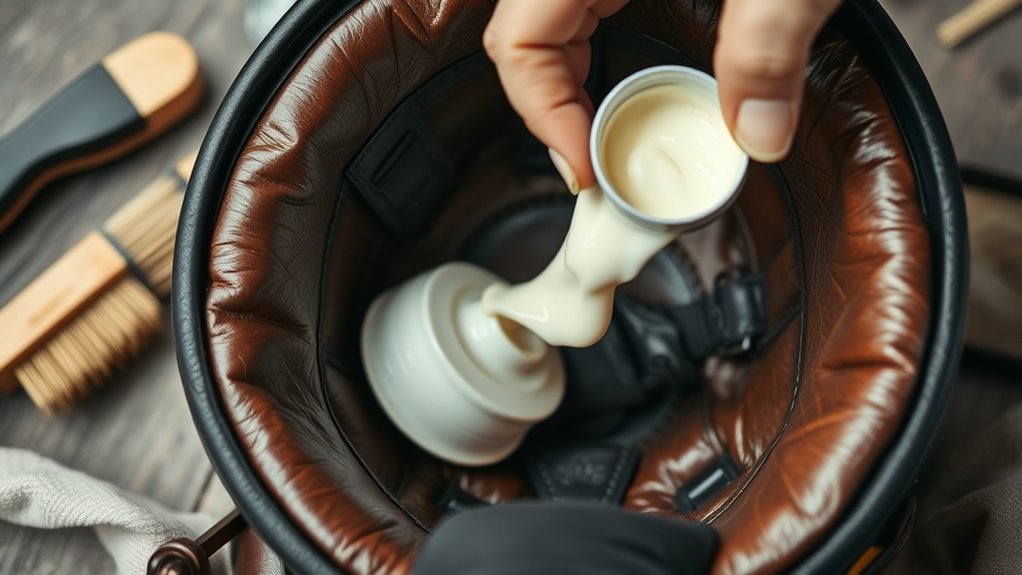
While keeping your leather helmet looking its best may seem challenging, a step-by-step cleaning process can simplify the task and secure longevity. Begin by identifying the leather type of your helmet, as different leather types may require specific care. Gather your cleaning supplies: a soft cloth, mild soap, and water.
| Step | Action |
|---|---|
| 1 | Remove any loose dirt |
| 2 | Dampen cloth with water |
| 3 | Apply mild soap gently |
| 4 | Wipe the interior thoroughly |
| 5 | Allow to air dry completely |
After cleaning, verify the helmet style maintains its shape. Following these steps will keep your leather helmet in prime condition, ready for your adventures!
Conditioning the Leather
When it comes to conditioning your leather helmet, selecting the right conditioner is essential for maintaining its integrity and appearance. You’ll want to apply it using techniques that guarantee even coverage, avoiding any potential damage to the leather. Finally, understanding how often to condition your helmet will help prolong its life and keep it looking its best.
Choosing the Right Conditioner
Choosing the right conditioner for leather helmet interiors is essential to maintaining their durability and comfort. You’ve got two main choices: natural conditioners and synthetic options. Natural conditioners, like beeswax or lanolin, penetrate deeply, nourishing the leather while enhancing its breathability. They’re often free of harsh chemicals, making them a safer choice for both you and the environment. On the other hand, synthetic options can provide a quick, convenient solution, often boasting added resistance to moisture and stains. However, they may not be as effective at conditioning over time. Evaluate your needs and preferences carefully; the right conditioner will prolong the life of your leather helmet, ensuring you enjoy the freedom of the ride without compromising comfort.
Application Techniques Explained
Applying conditioner to the leather interior of your helmet is an essential step in preserving its quality and comfort. Begin by cleaning the surface with a soft cloth to remove dust and dirt, ensuring proper helmet hygiene. Then, take a small amount of conditioner and apply it evenly using a clean applicator pad or soft cloth. Work in circular motions, allowing the conditioner to penetrate the leather, enhancing its suppleness. Pay special attention to seams and creases, where wear often occurs. After application, let the leather breathe for a few minutes before buffing off any excess product. This meticulous leather care routine not only extends the life of your helmet but also provides that freedom to ride comfortably and confidently.
Frequency of Conditioning
Regular conditioning is key to maintaining the health of your leather helmet interior. To guarantee longevity, aim to condition your helmet every 4 to 6 weeks, especially if you frequently ride or expose it to varying climates. This routine helps prevent dryness and cracking, which could lead to long term effects on both comfort and durability. If your helmet endures more intense conditions, increase the conditioning frequency to every 2 to 3 weeks. Pay attention to the leather’s texture; if it feels stiff or looks dull, it’s time to apply a quality conditioner. By doing so, you’ll preserve the leather’s natural oils, making sure it remains supple and resilient, ready to support your adventures with freedom and confidence.
Preventing Odors and Moisture Build-Up
To effectively prevent odors and moisture build-up in leather helmet interiors, you’ll want to incorporate a few essential practices. Begin by using moisture absorbers, such as silica gel packets, to draw excess humidity away from the leather. Place these in the helmet when it’s not in use; they’ll work silently to maintain a dry environment. You should also consider applying odor neutralizers like baking soda or specialized sprays designed for leather. These will combat unpleasant smells without damaging the material. Regularly airing out your helmet after use is vital too; just let it breathe in a well-ventilated area. With these practices, you’ll not only prolong the life of your helmet but also enhance your wearing experience.
Regular Maintenance Tips
While it may seem tempting to overlook routine care, maintaining your leather helmet is essential for its longevity and performance. Start a maintenance schedule that includes regular cleaning, using a damp cloth to wipe down the interior and remove sweat and dirt. Apply a leather conditioner every few months to keep the material supple and prevent cracking. Check for loose stitching or any signs of wear; addressing these issues early can save you from costly repairs later. Avoid exposing your helmet to extreme temperatures and direct sunlight, as this can damage the leather. Finally, always verify your helmet is dry before storing it. With diligent leather helmet care, you’ll enjoy both freedom on the road and the peace of mind that comes from proper upkeep.
Storing Your Leather Helmet Properly
Although you might think any space will do, storing your leather helmet properly is crucial to preserving its shape and integrity. To guarantee ideal helmet protection, follow these guidelines for proper storage:
- Choose a cool, dry place: Avoid humidity and direct sunlight.
- Use a helmet bag: A soft bag prevents scratches and dust accumulation.
- Store upright: Keep the helmet in an upright position to maintain its shape.
- Avoid heavy stacking: Don’t place heavy items on top, which can deform it.
- Check periodically: Regularly inspect for any signs of wear or damage.
Frequently Asked Questions
Can I Use Regular Soap on Leather Helmet Interiors?
You shouldn’t use regular soap on leather helmet interiors; it’s like pouring acid on a fine painting! Opt for soap alternatives specifically designed for leather maintenance, as they’re gentle yet effective. Look for pH-balanced cleaners that won’t strip the natural oils, ensuring your helmet remains supple. Remember, proper care not only extends its life but also enhances your freedom to enjoy every ride without worry. Treat it right, and it’ll treat you right!
How Often Should I Condition My Leather Helmet?
You should condition your leather helmet every 3 to 6 months, following frequency guidelines that guarantee the leather remains supple and protected. Depending on usage and environmental conditions, you may want to adjust this frequency. Use conditioning techniques like applying a small amount of conditioner with a soft cloth, assuring even coverage. By doing this, you’ll maintain the leather’s integrity and extend its lifespan, allowing you the freedom to enjoy your gear without worry.
Are There Specific Brands for Leather Cleaners?
Yes, there are specific brands you can trust for leather cleaners. Some of the best leather cleaners include Lexol, Leather Honey, and Bickmore. These leather care products are designed to nourish and protect your leather, ensuring longevity and a pristine appearance. Always check for pH-balanced formulas to avoid damage. You’ll find that using reputable brands helps maintain the quality of your leather items while giving you the freedom to enjoy them for years.
Is It Safe to Machine Wash Leather Helmet Interiors?
It’s generally not safe to machine wash leather helmet interiors. In fact, 70% of leather damage comes from improper cleaning methods. Machine washing can strip essential oils, causing the leather to crack and lose its shape. For ideal leather care, stick to gentle cleaning methods like using a damp cloth and specialized leather cleaners. This way, you’ll preserve the integrity and lifespan of your helmet while enjoying the freedom of safe, effective maintenance.
What Should I Do if My Leather Helmet Gets Wet?
If your leather helmet gets wet, act quickly to prevent moisture damage. First, gently blot excess water with a soft cloth. Avoid wringing or twisting the leather. Then, use leather drying techniques like air drying in a cool, shaded spot—never direct heat. You can stuff the helmet with newspaper to absorb moisture, but replace it as needed. Once dry, condition the leather to restore its suppleness and protect it from future damage.
